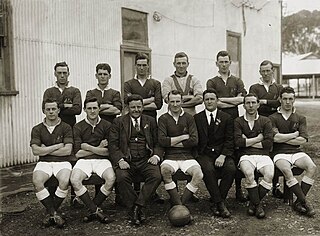Trevor Martin Chappell is a former Australian cricketer, a member of the South Australian Chappell family which excelled at cricket. He played 3 tests and 20 One Day Internationals for Australia. He won the Sheffield Shield with New South Wales twice, and scored a century for Australia against India in the 1983 World Cup. His career was overshadowed, however, by an incident in 1981 in which he bowled an underarm delivery to New Zealand cricketer Brian McKechnie to prevent the batsman from hitting a six.

John Dyson is a former international cricketer (batsman) who is now a cricket coach, most recently in charge of the West Indies.

The New South Wales rugby league team has represented the Australian state of New South Wales in rugby league football since the sport's beginnings there in 1907. Also known as the Blues due to their sky blue jerseys, the team competes in the annual State of Origin series against Queensland. For 2024, the team was coached by Michael Maguire and captained by Jake Trbojevic.

Reg Date was an Australian soccer player who plied his trade after the Second World War. Date played for Wallsend Football Club and Canterbury-Bankstown. He represented Australia in five full international matches, captaining three times.
Alex Gibb was an Australian soccer player who played half-back with Queensland clubs and the Queensland and Australia national teams. Gibb is recognised as Australia's first international captain, and was awarded Socceroo cap number one retrospectively in 2000 by Football Federation Australia, for Australia's first Test match against New Zealand, played in 1922.

Arthur "Jack" Verge was a rugby union player who represented Australia, New South Wales and Sydney University. Playing as a fullback, Verge won both his caps for Australia in 1904 against a touring team from the British Isles. Although he was relatively light for his position, he was repeatedly praised for his tackling and all-round defensive work, and in attack, he was a fast and deceptive runner. His kicking, on the other hand, was inconsistent.

The 1921–22 Kangaroo tour of Great Britain was the third ever Kangaroo tour. Again an Australasian side rather than an Australian team alone travelled to Great Britain to contest the Ashes. Coached by Arthur Hennessy and captained by Les Cubitt, the Kangaroos travelled on the RMS Tahiti to England for best-of-three series of Test matches against Great Britain for the Ashes. The tour took place during the 1921–22 Northern Rugby Football Union season and also featured matches against several of the clubs in that competition as well as other representative teams. The tour also involved some degree of player misbehaviour, with one young footballer almost sent home from San Francisco because of all the broken glasses following a drinking session on board the team's ship.

Alfred Quill was an Australian soccer player and played for the Australia national team. Often considered one of the best soccer players in New South Wales, he scored 868 goals in all NSW competitions in his 24-year senior career.
William "Podge" Maunder was an Australian soccer player. Maunder is recognised as the player who scored Australia's first international goal.

The Queensland women's rugby league team represents the Australian state of Queensland in rugby league football. Nicknamed the "Maroons", after the colour of their jersey, the team compete in the annual Women's State of Origin game against arch-rivals New South Wales. Coached by Tahnee Norris and captained by Ali Brigginshaw, the team is administered by the Queensland Rugby League.
Football Queensland Sunshine Coast is the governing body of football (soccer) on the Sunshine Coast, Queensland. It is a member zone of Football Queensland and Football Federation Australia.
Women's rugby league is a popular women's sport in Australia. The sport has a high level of participation in the country both recreational and professional. Australian Rugby League Commission (ARLC) is the national governing body of the sport in Australia, organising the Australian Women's Rugby League, the Australian women's national team, and the nine state governing bodies of the game, among other duties. Women's participation of modern rugby league has been recorded since the early 1920s. It has since become one of Australia's most popular women's team sports.
The 1946 Great Britain Lions tour was a tour by the Great Britain national rugby league team of Australia and New Zealand which took place between April and August 1946. The tour involved a schedule of 27 games: 20 in Australia including a three-test series against Australia for the Ashes, and a further 7 in New Zealand including one test match against New Zealand.
George Smith was an Australian professional soccer player who played as a forward. He captained the Australia national soccer team in 1933. Often considered the best centre-forward in Australian soccer in the 1930s, he had an average of 2.66 goals per game for Australia and has had many goalscoring records throughout his 17-year career.
Wilfred Bratton was an English-born Australian soccer player who also played as a forward for the inaugural Australia national soccer team in 1922.
Alec Cameron was an Australian professional soccer player who played as a forward and captained the Australia national soccer team.
The 1882 Southern Rugby Union season was the ninth season of the Sydney Rugby Premiership. Several clubs competed from May till August 1882. The season culminated in intercolonial matches against a touring Queensland team, and a tour to New Zealand by a team representing the Union.
This article summarises the Australia men's national soccer team in 1923.

This article summarises the Australia men's national soccer team in 1924.








